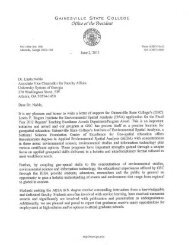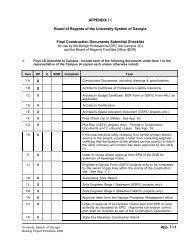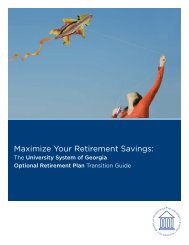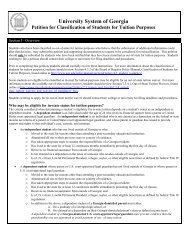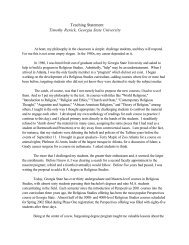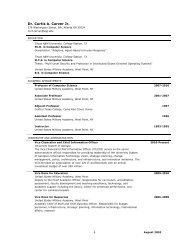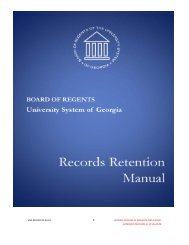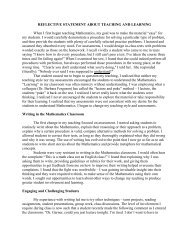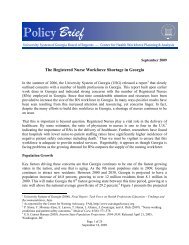66972 Federal Register / Vol. 75, No. 209 / Friday, October 29, 2010 / Rules and RegulationsWReier-Aviles on DSKGBLS3C1PROD with RULES2consistent approach to the development andimplementation <strong>of</strong> satisfactory academicprogress policies; updated and simplifiedprocedures for verifying FAFSA applicantinformation; updated regulations related tothe return <strong>of</strong> title IV, HEA funds when astudent withdraws; harmonization <strong>of</strong> DirectLoan and Teach Grant disbursementprocedures with other title IV, HEAprograms; and revised disbursementrequirements to ensure Federal Pell Grantrecipients can access funds in a timelymanner. As noted in the Regulatory ImpactAnalysis in the NPRM, these provisionsresult in no net costs to the FederalGovernment over 2011–2015.CostsAs discussed in the Regulatory ImpactAnalysis in the NPRM, many <strong>of</strong> theprovisions implemented through theseregulations will require regulated entities todevelop new disclosures and other materials,as well as accompanying disseminationprocesses. Other regulations generally willrequire discrete changes in specificparameters associated with existing guidanceand regulations—such as changes to title IV,HEA disbursement procedures, updatedprocesses for verification <strong>of</strong> FAFSAapplication information, clearer standards forthe return <strong>of</strong> title IV, HEA program fundsfollowing a student’s withdrawal, andupdated definitions and processes forconfirming the validity <strong>of</strong> a high schooldiploma—rather than wholly newrequirements. Accordingly, entities wishingto continue to participate in the title IV, HEAprograms have already absorbed many <strong>of</strong> theadministrative costs related to implementingthese regulations. Marginal costs over thisbaseline are primarily due to new proceduresthat, while possibly significant in some cases,are an unavoidable cost <strong>of</strong> continuedprogram participation.In assessing the potential impact <strong>of</strong> theseregulations, the <strong>Department</strong> recognizes thatcertain provisions are likely to increaseworkload for some program participants.This additional workload is discussed inmore detail under the Paperwork ReductionAct <strong>of</strong> 1995 section <strong>of</strong> this preamble.Additional workload would normally beexpected to result in estimated costsassociated with either the hiring <strong>of</strong> additionalemployees or opportunity costs related to thereassignment <strong>of</strong> existing staff from otheractivities. In total, these changes areestimated to increase burden on entitiesparticipating in the title IV, HEA programs by6,010,320 hours. Of this increased burden,3,862,165 hours are associated withinstitutions and 9,454 hours with ATB testpublishers, States, and ATB testadministrators. An additional 2,138,701hours are associated with borrowers,generally reflecting the time required to readnew disclosures or submit requiredinformation.As detailed in the Paperwork ReductionAct <strong>of</strong> 1995 section <strong>of</strong> these final regulations,the additional paperwork burden isattributable to several provisions, with thegreatest additional burden coming from therevised FAFSA verification process. Of the3.9 million hours <strong>of</strong> additional burdenassociated with institutions, 1.8 millionrelate to FAFSA verification. While theaverage number <strong>of</strong> items to be verified isexpected to decrease, the growth in thenumber <strong>of</strong> applicants and the requirement tosubmit all changes to the <strong>Department</strong> isestimated to increase overall burden. Otherpaperwork burden increases include thefollowing:• 750,725 hours related to academicreviews and development <strong>of</strong> academic plansunder § 668.34;• 425,075 hours related to calculation <strong>of</strong>unearned amounts when a studentwithdraws under § 668.22;• 262,990 hours associated with updatingmarital and dependency status under§ 668.55;• 376,417 hours annually and anadditional 300,773 hours in the initialreporting period related to the gainfulemployment reporting and disclosureprovisions in § 668.6;• 48,391 hours related to ATB testadministration and reporting under§§ 668.151 and 668.152;• 67,870 hours associated with disclosure<strong>of</strong> information about an institution’s writtenagreements in § 668.43;• 54,366 hours related to disbursement <strong>of</strong>funds to Pell Grant recipients for books andsupplies under § 668.164;• 21,982 hours related to the development<strong>of</strong> a high school diploma validation processand the validation <strong>of</strong> questionable diplomasunder § 668.16; and• 18,349 hours related to clock hour tocredit hour conversion and the inclusion <strong>of</strong>outside work for program eligibility under§ 668.8.For ATB test publishers, States, andadministrators, the increased burden <strong>of</strong> 9,454hours comes from the reporting, recordkeeping,test anomaly analysis, and otherrequirements in §§ 668.144, 668.150, and668.151. The increased burden on students isconcentrated in the FAFSA verification andstatus updating processes with 1,604,800hours under §§ 668.55, 668.56, and 668.59,with additional burden associated with thewithdrawal process under § 668.22 andsatisfactory academic progress policies under§ 668.34.Thus, for the specific informationcollections listed in the Paperwork ReductionAct <strong>of</strong> 1995 section <strong>of</strong> these final regulations,the total cost estimates are as follows:• For Information Collection 1845–0041,the total cost will be $72,594,870;• For Information Collection 1845–NEW2,the total cost attributable to these regulatorychanges will be $21,834,272;• For Information Collection 1845–0022,the total cost will be $15,533,671;• For Information Collection 1845–NEW1,the total cost attributable to the regulatorychanges will be $9,543,677 annually with anadditional $7,624,784 in the initial reportingperiod;• For Information Collection 1845–0049,the total cost will be $1,300,595; and• For Information Collection 1845–NEW3,the total cost attributable to these regulatorychanges will be $1,203,799.The monetized cost <strong>of</strong> this additionalburden, using wage data developed usingVerDate Mar2010 14:10 Oct 28, 2010 Jkt 223001 PO 00000 Frm 00142 Fmt 4701 Sfmt 4700 E:\FR\FM\29OCR2.SGM 29OCR2Bureau <strong>of</strong> Labor Statistics available athttp://www.bls.gov/ncs/ect/sp/ecsuphst.pdf,is $122,010,883, <strong>of</strong> which $86.7 million isassociated with institutions, $0.21 millionwith ATB test publishers, States, andadministrators, and $35.07 million withborrowers. For institutions, test publishers,and test administrators, an hourly rate <strong>of</strong>$22.14 was used to monetize the burden <strong>of</strong>these provisions. This was a blended ratebased on wages <strong>of</strong> $16.79 for <strong>of</strong>fice andadministrative staff and $38.20 for managers,assuming that <strong>of</strong>fice staff would perform 75percent <strong>of</strong> the work affected by theseregulations. For the gainful employmentprovision, an hourly rate <strong>of</strong> $25.35 was usedto reflect increased management time toestablish new data collection proceduresassociated with that provision. For students,the first quarter 2010 median weeklyearnings for full-time wage and salaryworkers were used. This was weighted toreflect the age pr<strong>of</strong>ile <strong>of</strong> the student loanportfolio, with half at the $457 per week <strong>of</strong>the 20 to 24 age bracket and half at the $691per week <strong>of</strong> the 25 to 34 year old bracket.This resulted in a $16.40 hourly wage rate touse in monetizing the burden on students.Because data underlying many <strong>of</strong> theseburden estimates was limited, in the NPRM,the <strong>Department</strong> requested comments andsupporting information for use in developingmore robust estimates. In particular, weasked institutions to provide detailed data onactual staffing and system costs associatedwith implementing these regulations. Inresponse to comments that the regulationswould be costly, we reviewed the wage ratesfor more recent information and the share <strong>of</strong>work performed by <strong>of</strong>fice workers andmanagement and pr<strong>of</strong>essional staff. Thisincreased the general wage rate from $18.63to $22.14 and the wage rate for gainfulemployment related matters from $20.71 to$25.35. The other areas that changed betweenthe NPRM published on June 18, 2010 andthese final regulations related to changes tothe disclosure requirements related to gainfulemployment that extended the reporting tostudents who began or completed programsbeginning July 1, 2006, required specifiedinformation for all students at a program, andestablished a requirement to report onstudent matriculations to higher credentialedprograms.Net Budget ImpactsThese regulations are estimated to have nonet budget impact over FY 2011–2015.Consistent with the requirements <strong>of</strong> theCredit Reform Act <strong>of</strong> 1990, budget costestimates for the student loan programsreflect the estimated net present value <strong>of</strong> allfuture non-administrative Federal costsassociated with a cohort <strong>of</strong> loans. (A cohortreflects all loans originated in a given fiscalyear.)These estimates were developed using the<strong>Office</strong> <strong>of</strong> Management and Budget’s CreditSubsidy Calculator. This calculator will alsobe used for re-estimates <strong>of</strong> prior-year costs,which will be performed each year beginningin FY 2009. The OMB calculator takesprojected future cash flows from the<strong>Department</strong>’s student loan cost estimationmodel and produces discounted subsidy
Federal Register / Vol. 75, No. 209 / Friday, October 29, 2010 / Rules and Regulations66973rates reflecting the net present value <strong>of</strong> allfuture Federal costs associated with awardsmade in a given fiscal year. Values arecalculated using a ‘‘basket <strong>of</strong> zeros’’methodology under which each cash flow isdiscounted using the interest rate <strong>of</strong> a zerocouponTreasury bond with the samematurity as that cash flow. To ensurecomparability across programs, thismethodology is incorporated into thecalculator and used governmentwide todevelop estimates <strong>of</strong> the Federal cost <strong>of</strong>credit programs. Accordingly, the<strong>Department</strong> believes it is the appropriatemethodology to use in developing estimatesfor these regulations. That said, however, indeveloping the following AccountingStatement, the <strong>Department</strong> consulted withOMB on how to integrate our discountingmethodology with the discountingmethodology traditionally used indeveloping regulatory impact analyses.Absent evidence <strong>of</strong> the impact theseregulations would have on student behavior,budget cost estimates were based on behavioras reflected in various <strong>Department</strong> data setsand longitudinal surveys listed underAssumptions, Limitations, and Data Sources.Program cost estimates were generated byrunning projected cash flows related to eachprovision through the <strong>Department</strong>’s studentloan cost estimation model. Student loan costestimates are developed across five riskcategories: Two-year proprietary institutions,two-year public and private, not-for-pr<strong>of</strong>itinstitutions; freshmen and sophomores atfour-year institutions, juniors and seniors atfour-year institutions, and graduate students.Risk categories have separate assumptionsbased on the historical pattern <strong>of</strong> behavior—for example, the likelihood <strong>of</strong> default or thelikelihood to use statutory deferment ordischarge benefits—<strong>of</strong> borrowers in eachcategory.The <strong>Department</strong> estimates no budgetaryimpact for most <strong>of</strong> these regulations as thereis no data indicating that the provisions willhave any impact on the volume orcomposition <strong>of</strong> the title IV, HEA programs.Assumptions, Limitations, and Data SourcesThe impact estimates provided in thepreceding section reflect a pre-statutorybaseline in which the HEOA changesimplemented in these regulations do notexist. Costs have been quantified for fiveyears.In developing these estimates, a wide range<strong>of</strong> data sources were used, including datafrom the National Student Loan Data System;operational and financial data from<strong>Department</strong> <strong>of</strong> <strong>Education</strong> systems, includingespecially the Fiscal Operations Report andApplication to Participate (FISAP); and datafrom a range <strong>of</strong> surveys conducted by theNational Center for <strong>Education</strong> Statistics suchas the 2008 National <strong>Postsecondary</strong> StudentAid Survey, the 1994 National <strong>Education</strong>Longitudinal Study, and the 1996 Beginning<strong>Postsecondary</strong> Student Survey. Data fromother sources, such as the U.S. CensusBureau, were also used. Data onadministrative burden at participatinginstitutions are extremely limited;accordingly, in the NPRM, the <strong>Department</strong>expressed interest in receiving comments inthis area. No comments were received.Elsewhere in this SUPPLEMENTARYINFORMATION section we identify and explainburdens specifically associated withinformation collection requirements. See theheading Paperwork Reduction Act <strong>of</strong> 1995.Accounting StatementAs required by OMB Circular A–4(available at http://www.Whitehouse.gov/omb/Circulars/a004/a-4.pdf), in Table 2, wehave prepared an accounting statementshowing the classification <strong>of</strong> theexpenditures associated with the provisions<strong>of</strong> these regulations. This table provides ourbest estimate <strong>of</strong> the changes in Federalstudent aid payments as a result <strong>of</strong> theseregulations. Expenditures are classified astransfers from the Federal Government tostudent loan borrowers.TABLE 2—ACCOUNTING STATEMENT:CLASSIFICATION OF ESTIMATED EX-PENDITURES[In millions]CategoryAnnualized MonetizedCosts.Annualized MonetizedTransfers.From Whom ToWhom?Transfers$126.1.Cost <strong>of</strong> compliancewith paperwork requirements.$0.Federal GovernmentTo Student LoanBorrowers.Regulatory Flexibility Act CertificationThe Secretary certifies that theseregulations will not have a significanteconomic impact on a substantial number <strong>of</strong>small entities. These regulations will affectinstitutions that participate in title IV, HEAprograms, ATB test publishers, andindividual students and loan borrowers. TheU.S. Small Business Administration SizeStandards define for-pr<strong>of</strong>it institutions as‘‘small businesses’’ if they are independentlyowned and operated and not dominant intheir field <strong>of</strong> operation with total annualrevenue below $7,000,000, and defines nonpr<strong>of</strong>itinstitutions as small organizations ifthey are independently owned and operatedand not dominant in their field <strong>of</strong> operation,or if they are institutions controlled bygovernmental entities with populationsbelow 50,000.Data from the Integrated <strong>Postsecondary</strong><strong>Education</strong> Data System (IPEDS) indicate thatroughly 4,379 institutions participating in theFederal student assistance programs meet thedefinition <strong>of</strong> ‘‘small entities.’’ The followingtable provides the distribution <strong>of</strong> institutionsand students by revenue category andinstitutional control.RevenuecategoryNumber <strong>of</strong>schoolsPublic Private NFP Proprietary TribalNumber <strong>of</strong>studentsNumber <strong>of</strong>schoolsNumber <strong>of</strong>studentsNumber <strong>of</strong>schoolsNumber <strong>of</strong>studentsNumber <strong>of</strong>schoolsNumber <strong>of</strong>studentsWReier-Aviles on DSKGBLS3C1PROD with RULES2$0 to $500,000 43 2,124 103 13,208 510 38,774 ...................... ......................$500,000 to $1million ........... 44 7,182 81 9,806 438 61,906 1 137$1 million to $3million ........... 98 29,332 243 65,614 745 217,715 3 555$3 million to $5million ........... 75 65,442 138 60,923 303 182,362 ...................... ......................$5 million to $7million ........... 49 73,798 99 62,776 224 185,705 5 2,525$7 million to $10million ........... 78 129,079 110 84,659 228 235,888 9 4,935$10 million andabove ............ 1,585 18,480,000 1,067 4,312,010 383 1,793,951 14 18,065Total .......... 1,972 18,786,957 1,841 4,608,996 2,831 2,716,301 32 26,217Approximately two-thirds <strong>of</strong> theseinstitutions are for-pr<strong>of</strong>it schools subject tothe disclosure and reporting requirementsrelated to programs leading to gainfulemployment. Other affected smallinstitutions include small communitycolleges and tribally controlled schools. Forthese institutions, the new disclosure andVerDate Mar2010 14:10 Oct 28, 2010 Jkt 223001 PO 00000 Frm 00143 Fmt 4701 Sfmt 4700 E:\FR\FM\29OCR2.SGM 29OCR2administrative requirements imposed underthe regulations could impose some new costsas described below. The impact <strong>of</strong> the
- Page 1 and 2:
Friday,October 29, 2010Part IIDepar
- Page 3 and 4:
Federal Register / Vol. 75, No. 209
- Page 6 and 7:
66836 Federal Register / Vol. 75, N
- Page 8 and 9:
66838 Federal Register / Vol. 75, N
- Page 10 and 11:
WReier-Aviles on DSKGBLS3C1PROD wit
- Page 12 and 13:
66842 Federal Register / Vol. 75, N
- Page 14 and 15:
66844 Federal Register / Vol. 75, N
- Page 16 and 17:
WReier-Aviles on DSKGBLS3C1PROD wit
- Page 18 and 19:
66848 Federal Register / Vol. 75, N
- Page 20 and 21:
66850 Federal Register / Vol. 75, N
- Page 22 and 23:
WReier-Aviles on DSKGBLS3C1PROD wit
- Page 24 and 25:
66854 Federal Register / Vol. 75, N
- Page 26 and 27:
WReier-Aviles on DSKGBLS3C1PROD wit
- Page 28 and 29:
66858 Federal Register / Vol. 75, N
- Page 30 and 31:
66860 Federal Register / Vol. 75, N
- Page 32 and 33:
66862 Federal Register / Vol. 75, N
- Page 34 and 35:
66864 Federal Register / Vol. 75, N
- Page 36 and 37:
66866 Federal Register / Vol. 75, N
- Page 38 and 39:
WReier-Aviles on DSKGBLS3C1PROD wit
- Page 40 and 41:
WReier-Aviles on DSKGBLS3C1PROD wit
- Page 42 and 43:
66872 Federal Register / Vol. 75, N
- Page 44 and 45:
WReier-Aviles on DSKGBLS3C1PROD wit
- Page 46 and 47:
WReier-Aviles on DSKGBLS3C1PROD wit
- Page 48 and 49:
WReier-Aviles on DSKGBLS3C1PROD wit
- Page 50 and 51:
66880 Federal Register / Vol. 75, N
- Page 52 and 53:
WReier-Aviles on DSKGBLS3C1PROD wit
- Page 54 and 55:
66884 Federal Register / Vol. 75, N
- Page 56 and 57:
66886 Federal Register / Vol. 75, N
- Page 58 and 59:
WReier-Aviles on DSKGBLS3C1PROD wit
- Page 60 and 61:
WReier-Aviles on DSKGBLS3C1PROD wit
- Page 62 and 63:
WReier-Aviles on DSKGBLS3C1PROD wit
- Page 64 and 65:
WReier-Aviles on DSKGBLS3C1PROD wit
- Page 66 and 67:
WReier-Aviles on DSKGBLS3C1PROD wit
- Page 68 and 69:
WReier-Aviles on DSKGBLS3C1PROD wit
- Page 70 and 71:
WReier-Aviles on DSKGBLS3C1PROD wit
- Page 72 and 73:
66902 Federal Register / Vol. 75, N
- Page 74 and 75:
WReier-Aviles on DSKGBLS3C1PROD wit
- Page 76 and 77:
WReier-Aviles on DSKGBLS3C1PROD wit
- Page 78 and 79:
66908 Federal Register / Vol. 75, N
- Page 80 and 81:
WReier-Aviles on DSKGBLS3C1PROD wit
- Page 82 and 83:
66912 Federal Register / Vol. 75, N
- Page 84 and 85:
WReier-Aviles on DSKGBLS3C1PROD wit
- Page 86 and 87:
66916 Federal Register / Vol. 75, N
- Page 88 and 89:
WReier-Aviles on DSKGBLS3C1PROD wit
- Page 90 and 91:
WReier-Aviles on DSKGBLS3C1PROD wit
- Page 92 and 93: WReier-Aviles on DSKGBLS3C1PROD wit
- Page 94 and 95: 66924 Federal Register / Vol. 75, N
- Page 96 and 97: WReier-Aviles on DSKGBLS3C1PROD wit
- Page 98 and 99: 66928 Federal Register / Vol. 75, N
- Page 100 and 101: WReier-Aviles on DSKGBLS3C1PROD wit
- Page 102 and 103: 66932 Federal Register / Vol. 75, N
- Page 104 and 105: WReier-Aviles on DSKGBLS3C1PROD wit
- Page 106 and 107: 66936 Federal Register / Vol. 75, N
- Page 108 and 109: 66938 Federal Register / Vol. 75, N
- Page 110 and 111: 66940 Federal Register / Vol. 75, N
- Page 112 and 113: 66942 Federal Register / Vol. 75, N
- Page 114 and 115: 66944 Federal Register / Vol. 75, N
- Page 116 and 117: 66946 Federal Register / Vol. 75, N
- Page 118 and 119: WReier-Aviles on DSKGBLS3C1PROD wit
- Page 120 and 121: WReier-Aviles on DSKGBLS3C1PROD wit
- Page 122 and 123: WReier-Aviles on DSKGBLS3C1PROD wit
- Page 124 and 125: 66954 Federal Register / Vol. 75, N
- Page 126 and 127: WReier-Aviles on DSKGBLS3C1PROD wit
- Page 128 and 129: 66958 Federal Register / Vol. 75, N
- Page 130 and 131: 66960 Federal Register / Vol. 75, N
- Page 132 and 133: WReier-Aviles on DSKGBLS3C1PROD wit
- Page 134 and 135: WReier-Aviles on DSKGBLS3C1PROD wit
- Page 136 and 137: WReier-Aviles on DSKGBLS3C1PROD wit
- Page 138 and 139: 66968 Federal Register / Vol. 75, N
- Page 140 and 141: 66970 Federal Register / Vol. 75, N
- Page 144 and 145: 66974 Federal Register / Vol. 75, N



